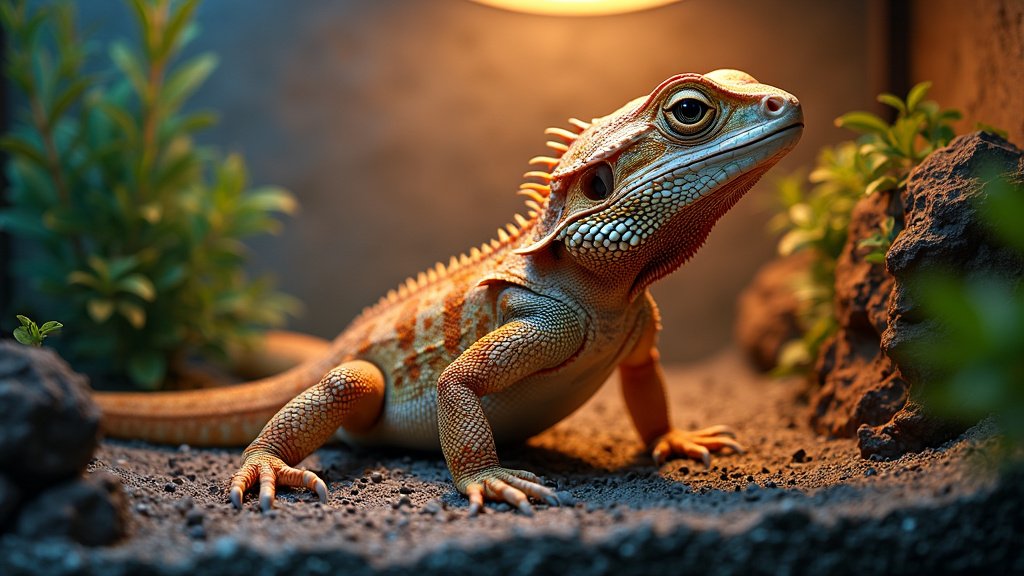Welcome to our comprehensive guide on creating the perfect temperature gradient for your bearded dragon’s tank. If you’re a bearded dragon owner or considering becoming one, ensuring that your pet has the right environment is crucial for their health and well-being. One of the key aspects of this environment is the temperature gradient within their tank. In this post, we’ll delve into everything you need to know to get this just right.
Why Temperature Gradients Matter
Temperature gradient is essential in a bearded dragon’s tank because it mimics their natural habitat. In the wild, bearded dragons move between warmer and cooler areas to regulate their body temperature. This is vital for various physiological processes, including digestion, immunity, and general activity levels.
Understanding the Basics
- Basking Spot: This should be the hottest area of the tank, where your bearded dragon can bask and absorb heat. The ideal temperature here ranges from 38°C to 42°C.
- Cool Side: This area allows your bearded dragon to escape the heat when necessary. It should be maintained at around 24°C to 27°C.
- Ambient Temperature: The general temperature of the tank, which should generally be about 29°C to 32°C.
Setting Up the Perfect Temperature Gradient
Creating a temperature gradient in your tank involves not just heaters and thermometers, but also understanding and mimicking your bearded dragon’s natural environment.
Choosing the Right Equipment
Heat Lamps and Basking Bulbs
Heat lamps and basking bulbs are your primary tools for creating a hot spot in the tank. Ensure the bulb you choose is appropriate for the size of your tank. As a rule of thumb, a 75-watt bulb is typically sufficient for a standard-sized tank.
My Experience: I’ve found ceramic heat emitters can be highly effective, especially for maintaining consistent overnight temperatures without any light emission, which can disturb your dragon’s sleep cycle.
UVB Lighting
Besides heat, UVB lighting is crucial for bearded dragons to synthesise vitamin D3, which is necessary for calcium absorption. Position the UVB light parallel to the heat source to ensure your bearded dragon gets the full spectrum of benefits while basking.
Expert Tip: Replace your UVB bulbs every six months as their effectiveness diminishes over time, even if they still emit light.
Monitoring and Adjusting Temperatures
It’s essential to continually monitor the temperatures in different parts of the tank to ensure a consistent gradient.
Thermometers
Invest in digital thermometers for accurate readings. Place one at the basking spot and another at the cool end to constantly monitor both areas.
Heat Adjustments
- Winter Adjustments: Keep in mind that room temperature variations can impact the tank’s temperature. In colder months, you may need to increase the wattage of your bulbs or add a secondary heat source.
- Summer Adjustments: Conversely, in warmer months, you might find it necessary to lower the wattage or change the photoperiod to maintain an optimal environment.
Pro Tip: Never use heat rocks, as they can cause severe burns.
Maintaining a Healthy Environment
Once you’ve set up the gradient, maintaining it is the next crucial step.
Regular Maintenance
Cleaning and Hygienic Practices
A clean tank helps in maintaining the desired temperature and preventing health issues. Spot-clean daily and perform a deep clean weekly.
Adjusting for Growth and Size
As your bearded dragon grows, their needs for heat and UVB will change. Observe your pet and adjust the tank setup as required.
Troubleshooting Common Issues
Cold Spots
If you identify cold spots in your tank, consider adding a secondary heat source or adjusting the position of your basking bulb.
Overheating
Conversely, if the tank gets too warm, consider using a thermostat to regulate the heat output or provide additional ventilation to dissipate excess heat.
Case Study: One winter, I noticed my bearded dragon became lethargic and wasn’t eating much. After checking the temperature gradient with my thermometers, I realised that the basking spot wasn’t hot enough. A quick switch to a higher wattage bulb solved the issue, and my dragon was back to their active self in no time.
Conclusion
Creating and maintaining a proper temperature gradient in your bearded dragon’s tank is not just about comfort; it’s a vital aspect of their health and longevity. By choosing the right equipment, monitoring temperatures, and making necessary adjustments, you can ensure your bearded dragon thrives.
Always remember, each bearded dragon is unique. If you ever notice symptoms that suggest health issues, consult with a vet experienced in reptile care.
For more information about bearded dragon care, check out our comprehensive care guide or visit Reptile Centre for a variety of supplies.
Meta Description
Understand the importance of temperature gradients in bearded dragon tanks. Learn how to set up, monitor, and maintain the ideal environment for your pet’s health and well-being. Expert tips included.
With these insights and practical tips, you’re now equipped to create the perfect home for your bearded dragon. Happy herping! 🦎

